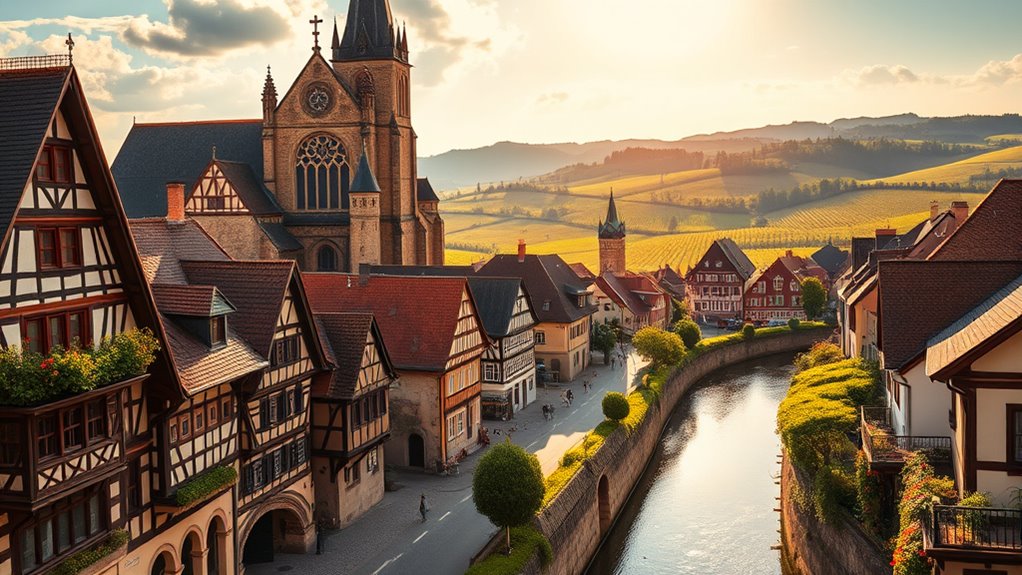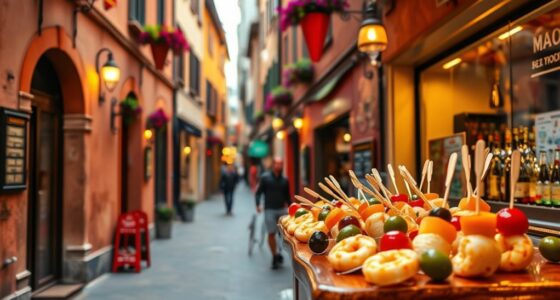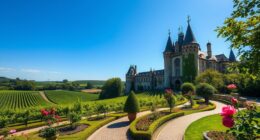Germany’s Romantic Road highlights include charming medieval towns like Rothenburg Ob Der Tauber and Dinkelsbühl, with well-preserved walls, towers, and colorful houses. You’ll also enjoy Würzburg’s stunning Baroque Residenz, Augsburg’s historic sites, and scenic spots like Schwangau with Neuschwanstein Castle. Riverside towns like Landsberg am Lech add natural beauty, and unique attractions like Augsburg’s Fuggerei showcase Germany’s rich social history. Exploring these sites offers a perfect mix of history, architecture, and breathtaking landscapes—continue to discover more treasures along your journey.
Key Takeaways
- Explore historic towns like Rothenburg Ob Der Tauber and Dinkelsbühl, renowned for medieval architecture and well-preserved city walls.
- Visit Würzburg’s UNESCO-listed Residenz, showcasing stunning Baroque art, architecture, and royal gardens.
- Discover Neuschwanstein Castle near Füssen, inspiring fairy-tale imagery and scenic mountain views.
- Experience Augsburg’s rich heritage with Roman relics, Renaissance art, and the historic Fuggerei social housing.
- Enjoy picturesque landscapes and outdoor activities in Schwangau, Landsberg am Lech, and the surrounding Bavarian Alps.
Würzburg: The Residenz and Baroque Splendor
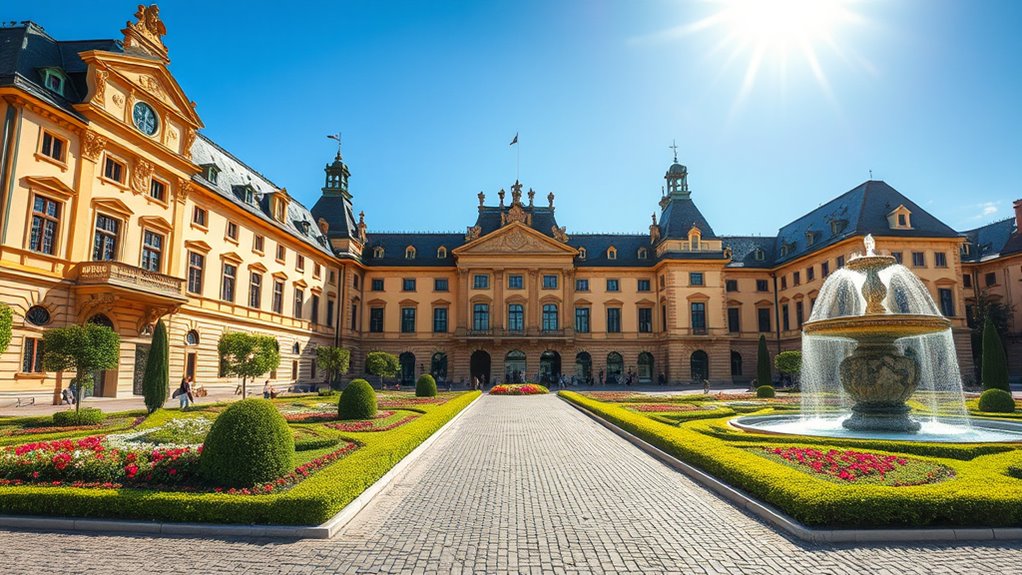
Nestled in the heart of Würzburg, the Residenz stands as a stunning example of Baroque architecture and royal grandeur. As you step inside, you’ll be captivated by its opulent halls, intricate stuccoes, and magnificent frescoes. The Grand Staircase greets you with its dramatic design, leading to lavish rooms that showcase the craftsmanship of the era. Don’t miss the Court Gardens, where carefully manicured landscapes complement the palace’s grandeur. The Residenz reflects the power and artistic vision of its creators, offering a glimpse into 18th-century aristocratic life. Every corner of this UNESCO World Heritage Site exudes elegance, inviting you to immerse yourself in the splendor of Baroque mastery and royal history. It’s a true highlight on Germany’s Romantic Road. Exploring Baroque architecture reveals the innovative artistic techniques used to create such breathtaking spaces, and understanding the contrast ratio of the interiors can deepen your appreciation for the design’s visual impact. Additionally, studying architectural innovation can enhance your understanding of the creative processes behind the grandeur of sites like this.
Rothenburg Ob Der Tauber: the Medieval Marvel

As you explore Rothenburg ob der Tauber, you’ll notice its charming medieval architecture that feels like stepping back in time. The city walls and gates stand as proud reminders of its historic defenses, inviting you to imagine life in the Middle Ages. This well-preserved marvel offers an enchanting glimpse into Germany’s rich past. Additionally, the town’s preservation efforts benefit from AI-driven personalization in e-learning, which can be used for educational programs to promote awareness of historical sites and heritage conservation. Recognizing the importance of local historical knowledge, community initiatives and regional expertise play a vital role in maintaining the town’s authenticity and attracting visitors, especially as public awareness of well-being continues to grow.
Medieval Architecture Charm
Rothenburg Ob Der Tauber fascinates visitors with its remarkably preserved medieval architecture, which seems to have stepped straight out of a fairy tale. As you wander through its narrow cobblestone streets, you’ll notice half-timbered houses with colorful facades and intricate woodwork, each telling a story of centuries past. The town’s buildings feature steeply pitched roofs, decorative gables, and tiny shutters that add to its charm. You’ll also see the iconic town hall with its ornate façade and the centuries-old churches that stand as proof to medieval craftsmanship. Every corner reveals a piece of history, inviting you to imagine life during the Middle Ages. The town’s authentic medieval character makes it a true living museum, offering a mesmerizing glimpse into Germany’s rich history. To enhance your visit, exploring the colorful street markets provides a delightful taste of local culture and crafts. Additionally, the town’s well-preserved medieval architecture is a testament to its historical significance and dedication to preservation.
City Walls & Gates
Surrounding Rothenburg Ob Der Tauber, the medieval city walls and gates stand as impressive tributes to its defensive history. As you walk along the well-preserved ramparts, you’ll see sturdy towers and battlements that once protected the town from invaders. The city walls extend nearly a mile, offering panoramic views of the charming old town below. You can also pass through historic gates like the Rödertor and Klingetor, each telling its own story of medieval defense. These structures give you a tangible connection to Rothenburg’s past, allowing you to imagine what life was like centuries ago. Exploring the walls and gates provides a fascinating glimpse into medieval architecture and the town’s resilient spirit, making your visit truly immersive. Louisiana Civil Code outlines legal guidelines for historic preservation and restoration efforts, ensuring these medieval structures are maintained for future generations. To fully appreciate the preservation of these structures, understanding the importance of historic preservation is essential for appreciating the town’s enduring heritage. Additionally, the well-preserved state of these defenses demonstrates the effectiveness of ongoing restoration initiatives.
Dinkelsbühl: A Timeless Walled Town
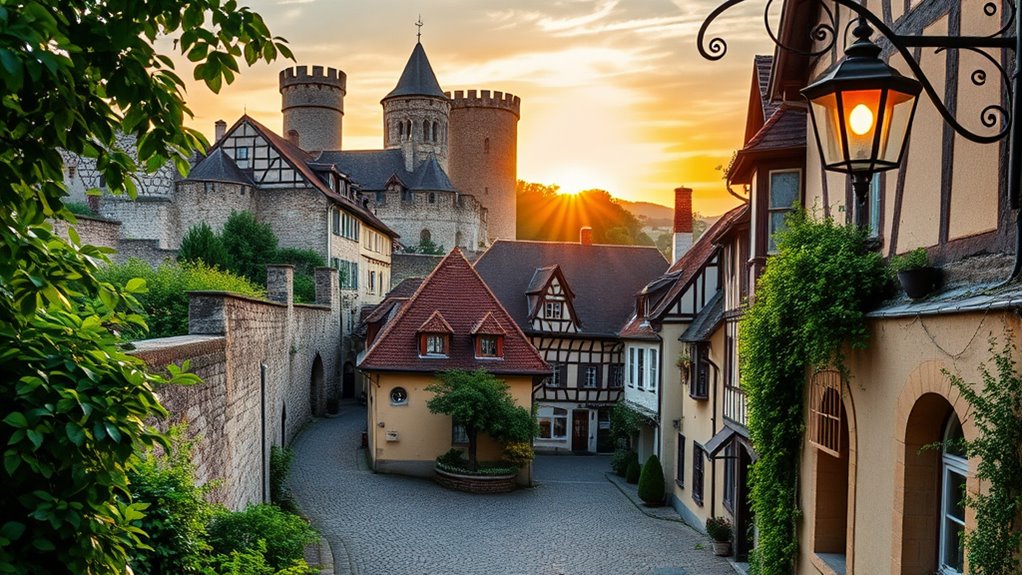
As you explore Dinkelsbühl, you’ll notice its well-preserved medieval town walls that still encircle the city. Stroll through the charming streets lined with half-timbered houses that exude timeless character. At the heart of the town, the historic town square invites you to experience its rich history and vibrant atmosphere.
Medieval Town Walls
Dinkelsbühl’s medieval town walls stand as a striking reminder of the city’s rich history, offering visitors a rare opportunity to walk along well-preserved fortifications that have withstood centuries. As you stroll along the ramparts, you’ll notice the sturdy stone walls, watchtowers, and gatehouses that once defended the town from invaders. The walls are mostly intact, providing an authentic glimpse into medieval military architecture. You can climb some sections for panoramic views of the charming streets below and the surrounding countryside. The walls not only served as protection but also as a symbol of Dinkelsbühl’s independence and resilience. Walking these historic defenses, you connect with centuries of history, experiencing firsthand the fortress-like atmosphere that defined this timeless walled town. Additionally, fostering creativity in a virtual environment, much like exploring historical sites, encourages innovative thinking and new perspectives, highlighting the importance of cultural preservation for future generations.
Charming Half-Timbered Houses
Walking through Dinkelsbühl, you’ll be captivated by its charming half-timbered houses, which perfectly embody the town’s timeless character. These buildings feature exposed wooden beams crisscrossing colorful facades, creating a storybook atmosphere. As you stroll, notice how each house reflects centuries of craftsmanship and tradition, with intricate carvings and playful designs. Many structures lean slightly, adding a whimsical charm. You might stop to admire the delicate latticework or the flower boxes spilling over windowsills. These houses aren’t just pretty—they tell stories of the town’s history and resilience. Walking past, you’ll feel transported to a different era, where craftsmanship and community spirit shine through in every timbered detail. They’re an authentic glimpse into Dinkelsbühl’s enduring heritage.
Historic Town Square
The town square of Dinkelsbühl stands as a vibrant heart where history and community converge. As you step onto the cobblestones, you’re greeted by medieval architecture and lively cafes. The square buzzes with activity, from locals chatting to markets filled with fresh produce. You’ll notice:
- Colorful guild banners fluttering above
- A centuries-old fountain at the center
- Elegant timber-framed buildings lining the perimeter
- Street musicians filling the air with melodies
- Cozy cafés inviting you to sit and watch the world go by
The atmosphere invites you to linger, soaking in the timeless charm of this walled town. It’s a perfect spot to connect with Dinkelsbühl’s rich history and lively spirit, all within a mesmerizing medieval setting.
Nördlingen: The Circular Medieval City
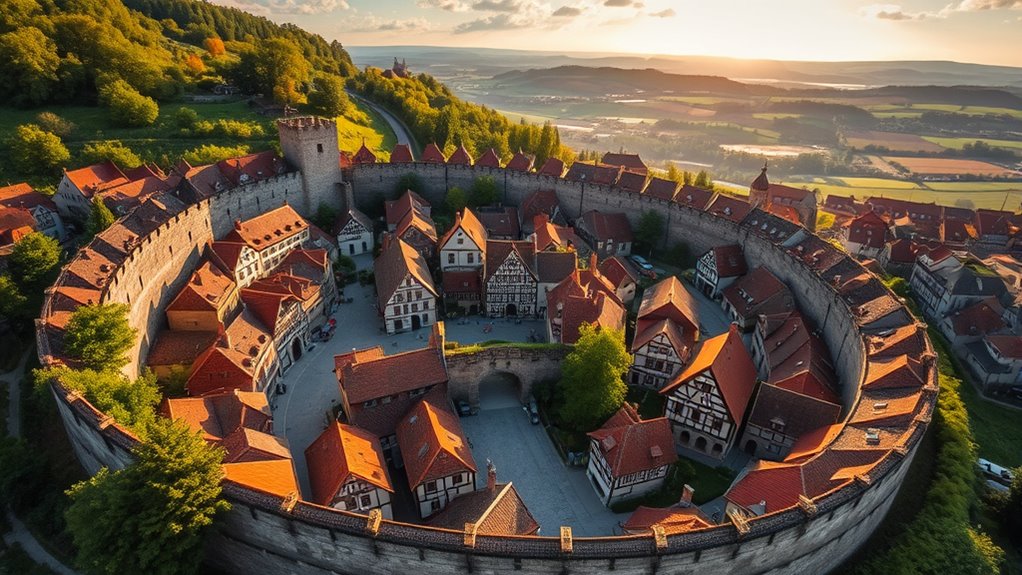
Nördlingen stands out with its remarkably well-preserved circular medieval walls that surround the entire old town. As you walk along the fortress-like ramparts, you’ll notice the town’s unique origin inside a crater formed by a meteor impact. The walls, built in the 14th century, feature seven towers and four gates, giving you a true sense of stepping back in time. You can climb the city’s walls for panoramic views of the rooftops and surrounding landscape. Inside, narrow cobblestone streets wind through charming houses and historic buildings, creating a mesmerizing atmosphere. The town square hosts lively markets and cozy cafes, perfect for soaking in local culture. Nördlingen’s medieval charm is both authentic and immersive, making it a must-see on your Romantic Road journey. Exploring the local culinary traditions can further enrich your visit, offering a taste of authentic regional flavors. Additionally, the town’s well-preserved history provides a window into medieval urban life, enhancing your cultural experience. To deepen your understanding, visiting local museums dedicated to medieval urban life can provide valuable insights into the past.
Augsburg: Germany’s Oldest City

As you explore Augsburg, you’ll notice its rich historical heritage that dates back over two millennia. The city is home to impressive architectural landmarks that showcase its long-standing cultural significance. These elements combine to make Augsburg a mesmerizing destination for history and architecture enthusiasts alike. Additionally, the city’s historical significance is reflected in its well-preserved old town and museums. To deepen your understanding, you can explore how the city’s cultural heritage has been preserved through various restoration efforts over the centuries. Notably, Augsburg’s architectural landmarks exemplify its enduring historical and cultural identity, which have been carefully maintained through restoration projects.
Rich Historical Heritage
Augsburg’s rich historical heritage unfolds through its impressive architecture and centuries-old traditions, making it a must-visit destination for history enthusiasts. As you explore, you’ll encounter a city layered with stories of its Roman origins, medieval merchants, and Renaissance innovators. Imagine wandering cobblestone streets lined with ancient guild houses, visiting the historic Fugger Palace, or standing in the bustling Town Hall square. The city’s heritage is reflected in:
- Roman relics and remnants of its founding
- Medieval guild halls and merchant houses
- Renaissance art and architecture
- The Fugger family’s influential history
- Traditional festivals celebrating its vibrant past
- Historical preservation efforts that maintain Augsburg’s architectural legacy
Each element offers a glimpse into Augsburg’s enduring legacy, inviting you to step back in time and experience its storied past firsthand.
Architectural Landmarks
The city’s impressive architectural landmarks stand as tangible attestations to Augsburg’s long and storied history. You’ll notice the breathtaking Renaissance-style Augsburg Cathedral, with its intricate façade and soaring tower. The Fuggerei, the world’s oldest social housing complex, showcases medieval charm and historical significance. Don’t miss the Rathaus, a stunning Renaissance building with detailed frescoes and a clock tower. These structures reveal Augsburg’s rich architectural evolution. Exploring cultural heritage through these landmarks offers a deeper appreciation of the city’s historical significance.
Cultural Significance
Because it’s Germany’s oldest city, Augsburg holds a unique place in the country’s cultural heritage. You can feel its rich history in the lively festivals, traditional crafts, and centuries-old customs that still thrive today. The city’s vibrant arts scene reflects its Renaissance legacy, blending modern creativity with historic roots. As you explore, imagine:
- Colorful markets bursting with local produce and handmade goods
- Medieval alleys echoing with stories from the past
- Festive celebrations honoring Augsburg’s history
- Art galleries showcasing centuries-old masterpieces
- Classic cafés where locals share tales over coffee
This deep-rooted cultural identity makes Augsburg more than just a scenic stop; it’s a living museum that celebrates Germany’s artistic and historical soul. Preservation of traditions and arts continues to inspire both residents and visitors alike, highlighting the importance of cultural heritage preservation in maintaining its unique character. Additionally, ongoing efforts to safeguard historical sites ensure that Augsburg’s rich legacy endures for future generations.
Füssen and Neuschwanstein Castle: Fairy Tale Castles and Alpine Views
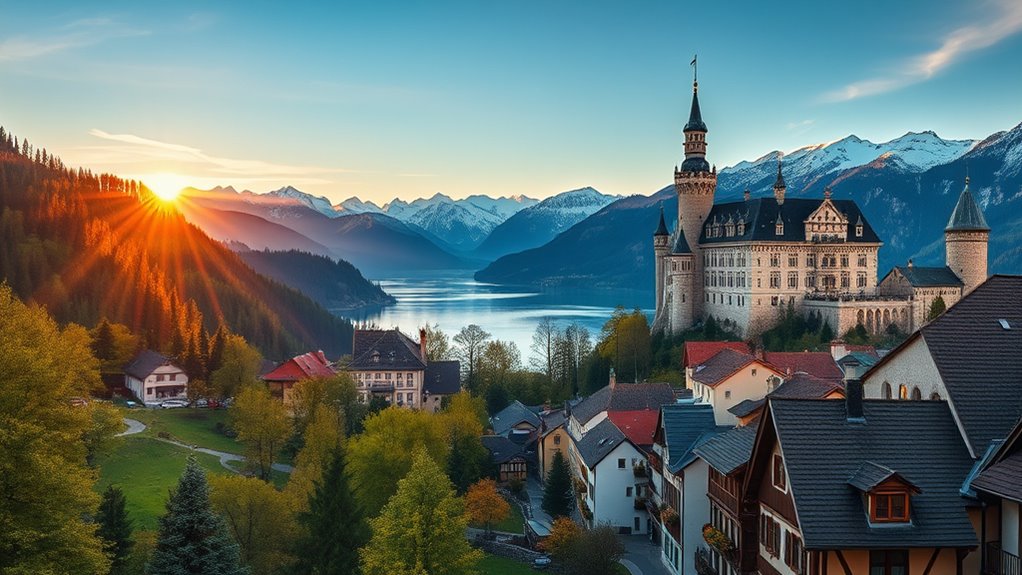
Nestled in the Bavarian Alps, Füssen is a charming town that serves as the perfect starting point for exploring the fairy-tale Neuschwanstein Castle, which looks like it’s straight out of a storybook. As you approach, you’ll be captivated by the castle’s turrets and white limestone walls rising dramatically against the mountain backdrop. You can walk along scenic paths that offer breathtaking alpine views and lush forests. Inside, the castle’s ornate interiors reveal Ludwig II’s dreamlike vision, while the surrounding landscape provides picture-perfect vistas. Whether you’re admiring the castle from afar or exploring its interiors, the blend of fairy-tale architecture and alpine scenery makes this a truly magical experience. It’s a highlight you won’t forget, filled with enchanting sights at every turn.
Bad Mergentheim: Spa Town and Medieval Charm
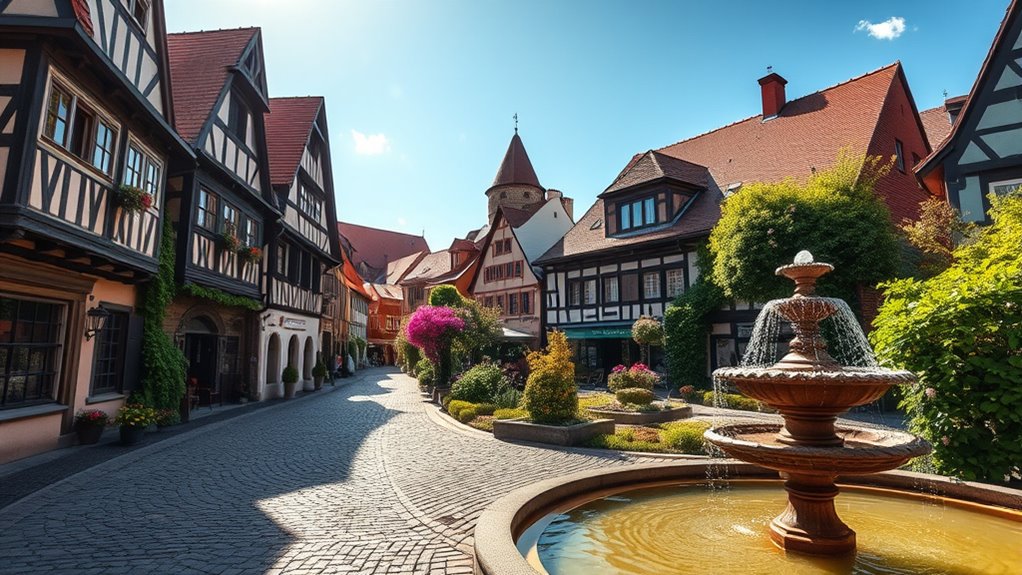
Leaving the enchanting fairy-tale scenery of Neuschwanstein, you’ll find yourself in Bad Mergentheim, a town renowned for its soothing thermal springs and well-preserved medieval charm. As you stroll through its historic streets, you’ll notice:
- A grand Renaissance-era castle overlooking the town
- Cobblestone alleys lined with half-timbered houses
- A lively market square with cafes and local vendors
- The elegant Kurpark, perfect for relaxing walks
- Ancient city walls that whisper stories of the past
- The town’s soundscape is enriched by the gentle sounds of flowing water and bustling market life, creating an immersive atmosphere for visitors.
- Visitors can also indulge in the thermal baths, known for their healing properties, or explore medieval churches and quaint shops. The town’s peaceful atmosphere invites you to unwind and immerse yourself in its rich history and restorative charm.
Schwangau: Gateway to the Bavarian Alps

Are you ready to experience the breathtaking beauty of the Bavarian Alps? Schwangau is your perfect gateway. Nestled at the foot of these majestic mountains, it offers stunning views and easy access to nature’s wonders. You’ll love exploring the charming village with its fairy-tale castles and lush surroundings. The highlight here is Neuschwanstein Castle, a fairytale fortress that seems straight out of a storybook. As you walk the scenic paths, you can enjoy panoramic vistas of snow-capped peaks and shimmering lakes. Schwangau also offers excellent hiking and cycling routes, making it ideal for outdoor enthusiasts. Whether you’re here to marvel at the castles or immerse yourself in alpine scenery, Schwangau promises an unforgettable start to your Bavarian adventure.
Landsberg Am Lech: Picturesque Riverside Town

Landsberg am Lech captivates visitors with its charming streets and scenic riverside setting. As you stroll through its historic center, you’ll notice colorful frescoed buildings, quaint cafes, and cobblestone alleys that invite exploration. The town’s location along the Lech River provides a peaceful backdrop, with gentle waves lapping against stone bridges. You might imagine:
- Brightly painted houses lining narrow streets
- A medieval fortress overlooking the town
- Flower boxes bursting with vibrant blooms
- Tiny cafes spilling onto the sidewalk
- Swans gliding gracefully on the river
This picturesque town combines history and beauty, making it a perfect stop to soak in Bavarian charm and enjoy tranquil riverside views.
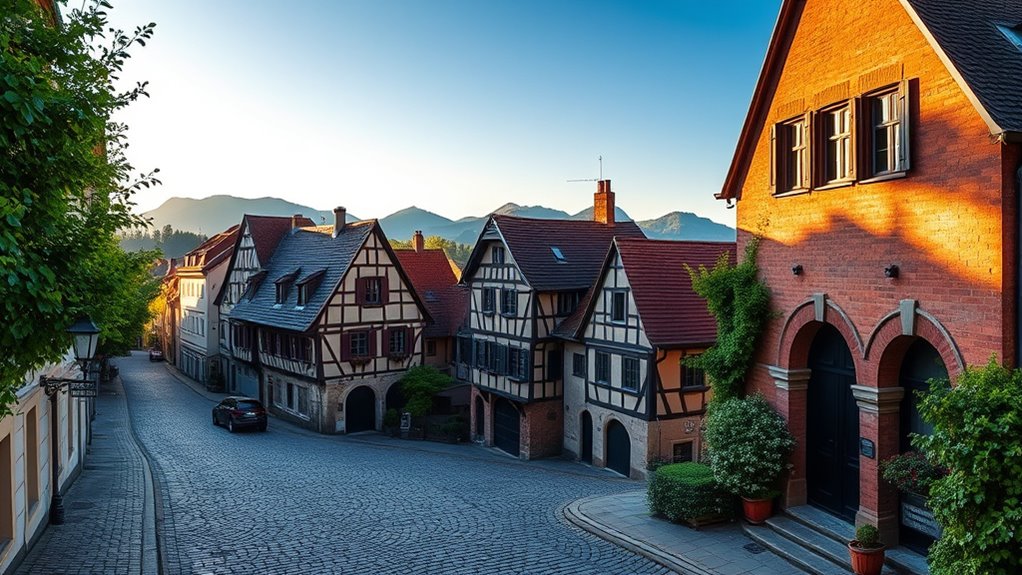
Nestled within Augsburg’s historic center, Fuggerei stands as the world’s oldest social housing complex, founded in 1521 by the Fugger family to provide affordable homes for the needy. As you walk through its narrow, cobblestone streets, you’ll see small, charming houses with red-tiled roofs, still inhabited today. The complex consists of nearly 70 buildings, forming a tight-knit community centered around a small square and a church. When you visit, you can explore the original gates, the well-preserved courtyards, and the museum that details its history. Fuggerei remains a living testament to social responsibility and charity, offering a unique glimpse into 16th-century philanthropy that still serves its purpose today. It’s a fascinating stop that highlights Augsburg’s rich history.
Frequently Asked Questions
What Are the Best Times of Year to Visit Germany’S Romantic Road?
The best time to visit Germany’s Romantic Road depends on your preferences. If you love mild weather and fewer crowds, spring (April to June) is ideal. Summer (July and August) offers warm weather and lively festivals, but it’s busier. Autumn (September to October) treats you to beautiful fall colors and harvest festivals. Winter (December) is magical with Christmas markets. Choose the season that matches your interests for an unforgettable trip.
Are There Guided Tours Available Along the Romantic Road?
You’re not alone in wanting to explore the Romantic Road with ease. Guided tours are widely available, offering a hassle-free way to discover Germany’s scenic highlights. Whether you prefer group excursions or private guides, you can find options that include transportation, expert commentary, and local insights. It’s a surefire way to make the most of your trip, so don’t hesitate to book a guided tour and enjoy the journey stress-free.
How Accessible Are the Towns for Travelers With Mobility Challenges?
You’ll find that many towns along the Romantic Road are quite accessible for travelers with mobility challenges. Most places offer paved sidewalks, ramps, and accessible transportation options. However, some historic sites and cobblestone streets might pose difficulties. It’s a good idea to plan ahead, check specific site accessibility, and consider guided tours that cater to mobility needs. With some preparation, you can enjoy a smooth and memorable visit.
What Local Dishes Should I Try in Each of These Towns?
You’ll want to savor the local flavors, from hearty sausages to sweet desserts. In Würzburg, try Franconian sausages and wine; in Rothenburg, indulge in Schneeball pastries; in Augsburg, enjoy Swabian potato salad and beer; in Füssen, taste Bavarian pretzels and roast pork; and in Heidelberg, savor traditional schnitzel and local wines. Each town offers unique dishes that reflect its rich culinary heritage, making your journey deliciously memorable.
Can I Travel the Romantic Road by Public Transportation?
You can definitely travel the Romantic Road by public transportation. Buses and trains connect major towns along the route, making it convenient to explore without a car. You’ll find regional transportation passes that can save you money and simplify travel plans. However, some smaller villages might have limited service, so plan your itinerary in advance. With a bit of planning, you’ll enjoy a smooth, scenic journey through Germany’s beautiful landscapes.
Conclusion
As you journey along Germany’s Romantic Road, you’ll uncover a tapestry of wonders so breathtaking, it’s almost surreal. From fairy-tale towns to majestic castles and charming streets that seem to leap straight out of a storybook, every stop promises an unforgettable adventure. Prepare to be utterly enchanted, as this route transforms your trip into a once-in-a-lifetime experience. Get ready to explore a world where history and beauty collide in the most extraordinary way imaginable.
